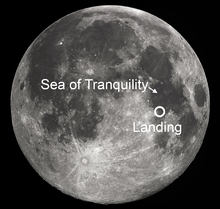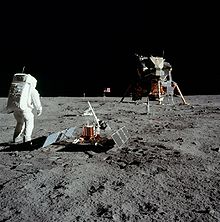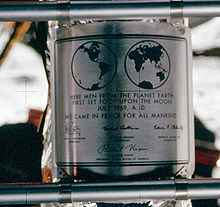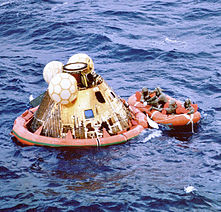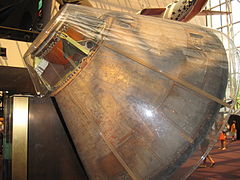
Apollo 11
Did you know...
This selection is made for schools by a children's charity read more. To compare sponsorship charities this is the best sponsorship link.
| Apollo 11 | |||||
|---|---|---|---|---|---|
Mission insignia |
|||||
| Mission statistics | |||||
| Mission name | Apollo 11 | ||||
| Command Module | CM-107. Mass 12,250 lb (5,560 kg) | ||||
| Service Module | SM-107. Mass 51,243 lb (23,243 kg) | ||||
| Lunar Module | LM-5. Mass 33,278 lb (15,095 kg) | ||||
| Crew size | 3 | ||||
| Call sign | CSM: Columbia. LM: Eagle in-flight; Tranquility Base on lunar surface | ||||
| Launch vehicle | Saturn V SA-506 | ||||
| Launch pad | LC 39A at KSC, Florida, USA | ||||
| Launch date | July 16, 1969, 13:32:00 UTC | ||||
| Lunar landing | July 20, 1969, 20:17:40 UTC at Sea of Tranquility First step: July 21, 02:56 UTC |
||||
| Lunar EVA duration | 2 h 36 m 40 s | ||||
| Lunar surface time | 21 h 36 m 21 s | ||||
| Lunar sample mass | 47.5 lb (21.5 kg) | ||||
| CSM time in lunar orbit | 59 h 30 m 25.79 s (30 orbits) | ||||
| Landing | July 24, 1969, 16:50:35 UTC. North Pacific Ocean, 13°19′N 169°9′W | ||||
| Mission duration | 8 d 03 h 18 m 35 s | ||||
| Crew photo | |||||
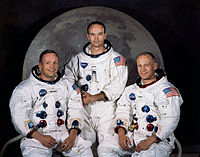 |
|||||
| Left to right: Armstrong, Collins, Aldrin | |||||
| Related missions | |||||
|
|||||
Apollo 11 was the spaceflight that landed the first humans, Americans Neil Armstrong and Buzz Aldrin, on the Moon on July 20, 1969, at 20:18 UTC. Armstrong became the first to step onto the lunar surface 6 hours later on July 21 at 02:56 UTC. Armstrong spent about two and a half hours outside the spacecraft, Aldrin slightly less; and together they collected 47.5 pounds (21.5 kg) of lunar material for return to Earth. A third member of the mission, Michael Collins, piloted the command spacecraft alone in lunar orbit until Armstrong and Aldrin returned to it for the trip back to Earth.
Launched by a Saturn V rocket from Kennedy Space Centre in Merritt Island, Florida on July 16, Apollo 11 was the fifth manned mission of NASA's Apollo program. The Apollo spacecraft had three parts: a Command Module with a cabin for the three astronauts which was the only part which landed back on Earth; a Service Module which supported the Command Module with propulsion, electrical power, oxygen and water; and a Lunar Module for landing on the Moon. After being sent to the Moon by the Saturn V's upper stage, the astronauts separated the spacecraft from it and travelled for three days until they entered into lunar orbit. Armstrong and Aldrin then moved into the Lunar Module and landed in the Sea of Tranquility. They stayed a total of about 21 and a half hours on the lunar surface. After lifting off in the upper part of the Lunar Module and rejoining Collins in the Command Module, they returned to Earth and landed in the Pacific Ocean on July 24.
Broadcast on live TV to a world-wide audience, Armstrong stepped onto the lunar surface and described the event as "one small step for [a] man, one giant leap for mankind." Apollo 11 effectively ended the Space Race and fulfilled a national goal proposed in 1961 by the late U.S. President John F. Kennedy in a speech before the United States Congress, "before this decade is out, of landing a man on the Moon and returning him safely to the Earth."
Framework
Crew
| Position | Astronaut | |
|---|---|---|
| Commander | Neil A. Armstrong | |
| Command Module Pilot | Michael Collins | |
| Lunar Module Pilot | Edwin "Buzz" E. Aldrin, Jr. | |
Each crewman of Apollo 11 had made a spaceflight before this mission, making it only the second all-veteran crew (the other being Apollo 10) in human spaceflight history.
Collins was originally slated to be the Command Module Pilot (CMP) on Apollo 8 but was removed when he required surgery on his back and was replaced by Jim Lovell, his backup for that flight. After Collins was medically cleared, he took what would have been Lovell's spot on Apollo 11; as a veteran of Apollo 8, Lovell was transferred to Apollo 11's backup crew, but promoted to backup commander.
Backup crew
| Position | Astronaut | |
|---|---|---|
| Commander | James A. Lovell, Jr. | |
| Command Module Pilot | William A. Anders | |
| Lunar Module Pilot | Fred W. Haise, Jr. | |
In early 1969, Bill Anders accepted a job with the National Space Council effective in August 1969 and announced his retirement as an astronaut. At that point Ken Mattingly was moved from the support crew into parallel training with Anders as backup Command Module Pilot in case Apollo 11 was delayed past its intended July launch (at which point Anders would be unavailable if needed) and would later join Lovell's crew and ultimately be assigned as the original Apollo 13 CMP.
Support crew
- Charlie Duke, Capsule Communicator (CAPCOM)
- Ronald Evans (CAPCOM)
- Owen K. Garriott (CAPCOM)
- Don L. Lind (CAPCOM)
- Ken Mattingly (CAPCOM)
- Bruce McCandless II (CAPCOM)
- Harrison Schmitt (CAPCOM)
- Bill Pogue
- Jack Swigert
Flight directors
- Cliff Charlesworth (Green Team), launch and EVA
- Gene Kranz (White Team), lunar landing
- Glynn Lunney (Black Team), lunar ascent
Call signs
After the crew of Apollo 10 named their spacecraft Charlie Brown and Snoopy, assistant manager for public affairs Julian Scheer wrote to Manned Spacecraft Centre director George M. Low to suggest the Apollo 11 crew be less flippant in naming their craft. During early mission planning, the names Snowcone and Haystack were used and put in the news release, but the crew later decided to change them.
The command module was named Columbia after the Columbiad, the giant cannon shell "spacecraft" fired by a giant cannon (coincidentally from Florida) in Jules Verne's 1865 novel From the Earth to the Moon. The lunar module was named Eagle for the national bird of the United States, the bald eagle, which is featured prominently on the mission insignia.
Insignia
The Apollo 11 mission insignia was designed by Collins, who wanted a symbol for "peaceful lunar landing by the United States." He chose an eagle as the symbol, put an olive branch in its beak, and drew a lunar background with the Earth in the distance. NASA officials said the talons of the eagle looked too "warlike" and after some discussion, the olive branch was moved to the claws. The crew decided the Roman numeral XI would not be understood in some nations and went with "Apollo 11;" they decided not to put their names on the patch, so it would "be representative of everyone who had worked toward a lunar landing."
All colors are natural, with blue and gold borders around the patch. When the Eisenhower dollar coin was released a few years later, the patch design provided the eagle for its reverse side. The design was retained for the smaller Susan B. Anthony dollar which was unveiled in 1979, ten years after the Apollo 11 mission.
Mission highlights
Launch and flight to lunar orbit
In addition to throngs of people crowding highways and beaches near the launch site, millions watched the event on television, with NASA Chief of Public Information Jack King providing commentary. President Richard Nixon viewed the proceedings from the Oval Office of the White House.
A Saturn V launched Apollo 11 from Launch Pad 39A, part of the Launch Complex 39 site at the Kennedy Space Centre on July 16, 1969 at 13:32:00 UTC (9:32:00 a.m. EDT local time). It entered orbit 12 minutes later. After one and a half orbits, the S-IVB third-stage engine pushed the spacecraft onto its trajectory toward the Moon with the Trans Lunar Injection burn at 16:22:13 UTC. About 30 minutes later the command/service module pair separated from this last remaining Saturn V stage and docked with the lunar module still nestled in the Lunar Module Adaptor. After the lunar module was extracted, the combined spacecraft headed for the Moon, while the third stage booster flew on a trajectory past the Moon and into heliocentric orbit.
On July 19 at 17:21:50 UTC, Apollo 11 passed behind the Moon and fired its service propulsion engine to enter lunar orbit. In the thirty orbits that followed, the crew saw passing views of their landing site in the southern Sea of Tranquility ( Mare Tranquillitatis) about 20 kilometres (12 mi) southwest of the crater Sabine D (0.67408N, 23.47297E). The landing site was selected in part because it had been characterized as relatively flat and smooth by the automated Ranger 8 and Surveyor 5 landers along with the Lunar Orbiter mapping spacecraft and unlikely to present major landing or extra-vehicular activity (EVA) challenges.
Lunar descent
On July 20, 1969 the lunar module (LM) Eagle separated from the command module Columbia. Collins, alone aboard Columbia, inspected Eagle as it pirouetted before him to ensure the craft was not damaged.
As the descent began, Armstrong and Aldrin found that they were passing landmarks on the surface 4 seconds early and reported that they were "long"; they would land miles west of their target point.
Five minutes into the descent burn, and 6,000 feet (1,800 m) above the surface of the Moon, the LM navigation and guidance computer distracted the crew with the first of several unexpected "1202" and "1201" program alarms. Inside Mission Control Centre in Houston, Texas, computer engineer Jack Garman told guidance officer Steve Bales it was safe to continue the descent and this was relayed to the crew. The program alarms indicated "executive overflows", meaning the guidance computer could not complete all of its tasks in real time and had to postpone some of them.
In a letter to Datamation, March 1, 1971, Margaret H. Hamilton, Director of Apollo Flight Computer Programming MIT Draper Laboratory, Cambridge, Massachusetts, stated: “Due to an error in the checklist manual, the rendezvous radar switch was placed in the wrong position. This caused it to send erroneous signals to the computer. The result was that the computer was being asked to perform all of its normal functions for landing while receiving an extra load of spurious data which used up 15% of its time. The computer (or rather the software in it) was smart enough to recognize that it was being asked to perform more tasks than it should be performing. It then sent out an alarm, which meant to the astronaut, I'm overloaded with more tasks than I should be doing at this time and I'm going to keep only the more important tasks; i.e., the ones needed for landing...Actually, the computer was programmed to do more than recognize error conditions. A complete set of recovery programs was incorporated into the software. The software's action, in this case, was to eliminate lower priority tasks and re-establish the more important ones...If the computer hadn't recognized this problem and taken recovery action, I doubt if Apollo 11 would have been the successful moon landing it was”.
Landing
When Armstrong again looked outside, he saw that the computer's landing target was in a boulder-strewn area just north and east of a 300 metres (980 ft) diameter crater (later determined to be "West crater", named for its location in the western part of the originally planned landing ellipse). Armstrong took semi-automatic control and, with Aldrin calling out altitude and velocity data, landed at 20:17 UTC on July 20 with about 25 seconds of fuel left.
Apollo 11 landed with less fuel than other missions, and the astronauts also encountered a premature low fuel warning. This was later found to have been due to greater propellant 'slosh' than expected, uncovering a fuel sensor. On subsequent missions, extra baffles were added to the tanks to prevent this.
Throughout the descent Aldrin had called out navigation data to Armstrong, who was busy piloting the LM. A few moments before the landing, a light informed Aldrin that at least one of the 67-inch (170 cm) probes hanging from Eagle's footpads had touched the surface, and he said "Contact light!". Three seconds later, Eagle landed and Armstrong said "Shutdown". Aldrin immediately said "Okay, engine stop. ACA - out of detent." Armstrong acknowledged "Out of detent. Auto" and Aldrin continued "Mode control - both auto. Descent engine command override off. Engine arm - off. 413 is in."
Charles Duke, acting as CAPCOM during the landing phase, acknowledged their landing by saying "We copy you down, Eagle".
Armstrong acknowledged Aldrin's completion of the post landing checklist with "Engine arm is off." before responding to Duke with the words, "Houston, Tranquility Base here. The Eagle has landed." Armstrong's change of call sign from "Eagle" to "Tranquility Base" confirmed that landing was complete and successful, and Duke mispronounced his reply as he expressed the relief at Mission Control: "Roger, Twan-- Tranquility, we copy you on the ground. You got a bunch of guys about to turn blue. We're breathing again. Thanks a lot."
Two and a half hours after landing, before preparations began for the EVA, Aldrin broadcast that:
"This is the LM pilot. I'd like to take this opportunity to ask every person listening in, whoever and wherever they may be, to pause for a moment and contemplate the events of the past few hours and to give thanks in his or her own way."
He then took communion privately. At this time NASA was still fighting a lawsuit brought by atheist Madalyn Murray O'Hair (who had objected to the Apollo 8 crew reading from the Book of Genesis) demanding that their astronauts refrain from broadcasting religious activities while in space. As such, Aldrin chose to refrain from directly mentioning taking communion on the moon. Aldrin was an elder at the Webster Presbyterian Church and his communion kit was prepared by the pastor of the church, the Rev. Dean Woodruff. Aldrin described communion on the Moon and the involvement of his church and pastor in the October 1970 edition of Guideposts magazine and in his book Return to Earth. Webster Presbyterian possesses the chalice used on the Moon and commemorates the event each year on the Sunday closest to July 20.
The schedule for the mission called for the astronauts to follow the landing with a five-hour sleep period, since they had been awake since early morning. However, they elected to forgo the sleep period and begin the preparations for the EVA early, thinking that they would be unable to sleep.
Lunar surface operations
The astronauts planned placement of the Early Apollo Scientific Experiment Package (EASEP) and the U.S. flag by studying their landing site through Eagle's twin triangular windows, which gave them a 60° field of view. Preparation required longer than the two hours scheduled. Armstrong initially had some difficulties squeezing through the hatch with his Portable Life Support System (PLSS). According to veteran moon-walker John Young, a redesign of the LM to incorporate a smaller hatch had not been followed by a redesign of the PLSS backpack, so some of the highest heart rates recorded from Apollo astronauts occurred during LM egress and ingress.
At 02:39 UTC on Monday July 21, 1969, Armstrong opened the hatch, and at 02:51 UTC began his descent to the lunar surface. The Remote Control Unit controls on his chest kept him from seeing his feet. Climbing down the nine-rung ladder, Armstrong pulled a D-ring to deploy the Modular Equipment Stowage Assembly (MESA) folded against Eagle's side and activate the TV camera, and at 02:56:15 UTC he set his left foot on the surface. The first landing used slow-scan television incompatible with commercial TV, so it was displayed on a special monitor and a conventional TV camera viewed this monitor, significantly reducing the quality of the picture. The signal was received at Goldstone in the United States but with better fidelity by Honeysuckle Creek Tracking Station in Australia. Minutes later the feed was switched to the more sensitive Parkes radio telescope in Australia. Despite some technical and weather difficulties, ghostly black and white images of the first lunar EVA were received and broadcast to at least 600 million people on Earth. Although copies of this video in broadcast format were saved and are widely available, recordings of the original slow scan source transmission from the lunar surface were accidentally destroyed during routine magnetic tape re-use at NASA.
After describing the surface dust as "very fine-grained" and "almost like a powder", Armstrong stepped off Eagle's footpad and uttered his famous line, "That's one small step for [a] man, one giant leap for mankind" six and a half hours after landing. Aldrin joined him, describing the view as "Magnificent desolation."
 |
"That's one small step..."
|
| Problems listening to this file? See media help. | |
About seven minutes after stepping onto the Moon's surface, Armstrong collected a contingency soil sample using a sample bag on a stick. He then folded the bag and tucked it into a pocket on his right thigh. This was to guarantee there would be some lunar soil brought back in case an emergency required the astronauts to abandon the EVA and return to the LM.
In addition to fulfilling President John F. Kennedy's mandate to land a man on the Moon before the end of the 1960s, Apollo 11 was an engineering test of the Apollo system; therefore, Armstrong snapped photos of the LM so engineers would be able to judge its post-landing condition. He removed the TV camera from the MESA and made a panoramic sweep, then mounted it on a tripod 68 feet (21 m) from the LM. The TV camera cable remained partly coiled and presented a tripping hazard throughout the EVA.
Armstrong said that moving in the lunar gravity, one-sixth of Earth's, was "even perhaps easier than the simulations... It's absolutely no trouble to walk around". Aldrin joined him on the surface and tested methods for moving around, including two-footed kangaroo hops. The PLSS backpack created a tendency to tip backwards, but neither astronaut had serious problems maintaining balance. Loping became the preferred method of movement. The astronauts reported that they needed to plan their movements six or seven steps ahead. The fine soil was quite slippery. Aldrin remarked that moving from sunlight into Eagle's shadow produced no temperature change inside the suit, though the helmet was warmer in sunlight, so he felt cooler in shadow.
The astronauts planted a specially designed U.S. flag on the lunar surface, in clear view of the TV camera. Some time later, President Richard Nixon spoke to them through a telephone-radio transmission which Nixon called "the most historic phone call ever made from the White House." Nixon originally had a long speech prepared to read during the phone call, but Frank Borman, who was at the White House as a NASA liaison during Apollo 11, convinced Nixon to keep his words brief, to respect the lunar landing as Kennedy's legacy.
The MESA failed to provide a stable work platform and was in shadow, slowing work somewhat. As they worked, the moonwalkers kicked up gray dust which soiled the outer part of their suits, the integrated thermal meteoroid garment.
They deployed the EASEP, which included a passive seismograph and a laser ranging retroreflector. Then Armstrong loped about 120 metres (390 ft) from the LM to snap photos at the rim of Little West Crater while Aldrin collected two core tubes. He used the geological hammer to pound in the tubes - the only time the hammer was used on Apollo 11. The astronauts then collected rock samples using scoops and tongs on extension handles. Many of the surface activities took longer than expected, so they had to stop documenting sample collection halfway through the allotted 34 min.
Three new minerals were discovered in the rock samples collected by the astronauts: armalcolite, tranquillityite, and pyroxferroite. Armalcolite was named after Armstrong, Aldrin, and Collins.
During this period Mission Control used a coded phrase to warn Armstrong that his metabolic rates were high and that he should slow down. He was moving rapidly from task to task as time ran out. However, as metabolic rates remained generally lower than expected for both astronauts throughout the walk, Mission Control granted the astronauts a 15-minute extension.
Lunar ascent and return
Aldrin entered Eagle first. With some difficulty the astronauts lifted film and two sample boxes containing more than 22 kilograms (49 lb) of lunar surface material to the LM hatch using a flat cable pulley device called the Lunar Equipment Conveyor. Armstrong reminded Aldrin of a bag of memorial items in his suit pocket sleeve, and Aldrin tossed the bag down; Armstrong then jumped to the ladder's third rung and climbed into the LM. After transferring to LM life support, the explorers lightened the ascent stage for return to lunar orbit by tossing out their PLSS backpacks, lunar overshoes, one Hasselblad camera, and other equipment. They then pressurized the LM, and settled down to sleep.
While moving within the cabin, Aldrin accidentally broke the circuit breaker that would arm the main engine for lift off from the Moon. There was concern this would prevent firing the engine, stranding them on the Moon. Fortunately a felt-tip pen was sufficient to activate the switch. Had this not worked, the Lunar Module circuitry could have been reconfigured to allow firing the ascent engine.
After about seven hours of rest, the crew was awakened by Houston to prepare for the return flight. Two and a half hours later, at 17:54 UTC, they lifted off in Eagle's ascent stage, carrying 21.5 kilograms of lunar samples with them, to rejoin CMP Michael Collins aboard Columbia in lunar orbit. During the launch Aldrin looked up in time to see the exhaust from the ascent module's engine knock over the American flag they had planted.
After more than 2½ hours on the lunar surface, they had left behind scientific instruments that included a retroreflector array used for the Lunar Laser Ranging Experiment and a Passive Seismic Experiment used to measure Moon quakes. They also left an American flag, an Apollo 1 mission patch, and a plaque (mounted on the LM Descent Stage ladder) bearing two drawings of Earth (of the Western and Eastern Hemispheres), an inscription, and signatures of the astronauts and President Richard M. Nixon. The inscription read:
Here men from the planet Earth first set foot upon the Moon, July 1969 A.D. We came in peace for all mankind.
They also left behind a memorial bag containing a gold replica of an olive branch as a traditional symbol of peace and a silicon message disk. The disk carries the goodwill statements by Presidents Eisenhower, Kennedy, Johnson and Nixon and messages from leaders of 73 countries around the world. The disc also carries a listing of the leadership of the US Congress, a listing of members of the four committees of the House and Senate responsible for the NASA legislation, and the names of NASA's past and present top management. (In his 1989 book, Men from Earth, Aldrin says that the items included Soviet medals commemorating Cosmonauts Vladimir Komarov and Yuri Gagarin.) Also, according to Deke Slayton's book Moonshot, Armstrong carried with him a special diamond-studded astronaut pin from Slayton.
Film taken from the LM Ascent Stage upon liftoff from the Moon reveals the American flag, planted some 25 feet (8 m) from the descent stage, whipping violently in the exhaust of the ascent stage engine. Buzz Aldrin witnessed it topple: "The ascent stage of the LM separated ...I was concentrating on the computers, and Neil was studying the attitude indicator, but I looked up long enough to see the flag fall over." Subsequent Apollo missions usually planted the American flags at least 100 feet (30 m) from the LM to prevent its being blown over by the ascent engine exhaust.
After rendezvous with Columbia, Eagle's ascent stage was jettisoned into lunar orbit on July 21, 1969 at 23:41 UTC. Just before the Apollo 12 flight, it was noted that Eagle was still likely to be orbiting the Moon. Later NASA reports mentioned that Eagle's orbit had decayed, resulting in it impacting in an "uncertain location" on the lunar surface. The location is uncertain because the Eagle ascent stage was not tracked after it was jettisoned, and the lunar gravity field is sufficiently non-uniform to make the orbit of the spacecraft unpredictable after a short time. NASA estimated that the orbit had decayed within months and would have impacted on the Moon.
On July 23, the last night before splashdown, the three astronauts made a television broadcast in which Collins commented,
- "... The Saturn V rocket which put us in orbit is an incredibly complicated piece of machinery, every piece of which worked flawlessly ... We have always had confidence that this equipment will work properly. All this is possible only through the blood, sweat, and tears of a number of a people ...All you see is the three of us, but beneath the surface are thousands and thousands of others, and to all of those, I would like to say, 'Thank you very much.'"
Aldrin added,
- "This has been far more than three men on a mission to the Moon; more, still, than the efforts of a government and industry team; more, even, than the efforts of one nation. We feel that this stands as a symbol of the insatiable curiosity of all mankind to explore the unknown ... Personally, in reflecting on the events of the past several days, a verse from Psalms comes to mind. 'When I consider the heavens, the work of Thy fingers, the Moon and the stars, which Thou hast ordained; What is man that Thou art mindful of him?'"
Armstrong concluded,
- "The responsibility for this flight lies first with history and with the giants of science who have preceded this effort; next with the American people, who have, through their will, indicated their desire; next with four administrations and their Congresses, for implementing that will; and then, with the agency and industry teams that built our spacecraft, the Saturn, the Columbia, the Eagle, and the little EMU, the spacesuit and backpack that was our small spacecraft out on the lunar surface. We would like to give special thanks to all those Americans who built the spacecraft; who did the construction, design, the tests, and put their hearts and all their abilities into those craft. To those people tonight, we give a special thank you, and to all the other people that are listening and watching tonight, God bless you. Good night from Apollo 11."
On the return to Earth, a bearing at the Guam tracking station failed, which would have prevented communication on the last segment of the Earth return. A regular repair was not possible in the available time but the station director, Charles Force, had his ten-year old son Greg use his small hands to reach into the housing and pack it with grease. Greg later was thanked by Armstrong.
Splashdown and quarantine
On July 24, the astronauts returned home aboard the command module Columbia just before dawn local time (16:51 UTC) at 13°19′N 169°9′W, in the Pacific Ocean 2,660 km (1,440 nmi) east of Wake Island, 380 km (210 nmi) south of Johnston Atoll, and 24 km (13 nmi) from the recovery ship, USS Hornet.
At 16:44 UTC the drogue parachutes had been deployed and 7 minutes later the command module struck the water forcefully. The command module landed upside down but was righted within 10 minutes by flotation bags triggered by the astronauts. "Everything's okay. Our checklist is complete. Awaiting swimmers," was Armstrong's last official transmission from the Columbia. A diver from the Navy helicopter hovering above attached a sea anchor to the command module to prevent it from drifting. Additional divers attached flotation collars to stabilize the module and position rafts for astronaut extraction. Though the chance of bringing back pathogens from the lunar surface was considered remote, it was considered a possibility and NASA took great precautions at the recovery site. Divers provided the astronauts with Biological Isolation Garments (BIGs) which were worn until they reached isolation facilities on board the Hornet. Additionally astronauts were rubbed down with a sodium hypochlorite solution and the command module wiped with Betadine to remove any lunar dust that might be present. The raft containing decontamination materials was then intentionally sunk.
A second Sea King helicopter hoisted the astronauts aboard one by one, where a NASA flight surgeon gave each a brief physical check during the 0.5 nautical miles (930 m) trip back to the Hornet.
After touchdown on the Hornet, the astronauts exited the helicopter, leaving the flight surgeon and three crewmen. The helicopter was then lowered into hangar bay #2 where the astronauts walked the 30 feet (9.1 m) to the Mobile Quarantine Facility (MQF) where they would begin their 21 days of quarantine. This practice would continue for two more Apollo missions, Apollo 12 and Apollo 14, before the Moon was proven to be barren of life and the quarantine process dropped.
President Richard Nixon was aboard Hornet to personally welcome the astronauts back to Earth. He told the astronauts, "As a result of what you've done, the world has never been closer together before." After Nixon departed, the Hornet was brought alongside the five-ton command module where it was placed aboard by the ship's crane, placed on a dolly and moved next to the MQF. The Hornet sailed for Pearl Harbor where the command module and MQF were airlifted to the Johnson Space Centre.
Years later, it was publicly revealed that Nixon had prepared a speech to be given in the event the Lunar Module had failed to lift off from the lunar surface, which would have resulted in Armstrong's and Aldrin's deaths, similar to common newspaper obituary or government contingency plan procedures and policies.
In accordance with the recently passed Extra-Terrestrial Exposure Law, the astronauts were placed in quarantine for fear that the Moon might contain undiscovered pathogens and that the astronauts might have been exposed to them during their Moon walks. However, after almost three weeks in confinement (first in their trailer and later in the Lunar Receiving Laboratory at the Manned Spacecraft Centre), the astronauts were given a clean bill of health. On August 10, 1969, the astronauts exited quarantine.
Celebration
On August 13, they rode in parades in their honour in New York, Chicago, and Los Angeles. On the same evening in Los Angeles there was an official State Dinner to celebrate the flight, attended by members of Congress, 44 governors, the Chief Justice of the United States, and ambassadors from 83 nations at the Century Plaza Hotel. President Richard Nixon and Vice President Spiro T. Agnew honored each astronaut with a presentation of the Presidential Medal of Freedom. This celebration was the beginning of a 45-day "Giant Leap" tour that brought the astronauts to 25 foreign countries and included visits with prominent leaders such as Queen Elizabeth II of the United Kingdom. Many nations would honour the first manned Moon landing by issuing Apollo 11 commemorative postage stamps or coins.
On September 16, 1969, the three astronauts spoke before a joint session of Congress on Capitol Hill. They presented two U.S. flags, one to the House of Representatives and the other to the Senate, that had been carried to the surface of the Moon with them.
Moon race
The Soviet Union was secretly attempting to compete with the US in landing a man on the Moon, but had been hampered by repeated failures in development of a launcher comparable to the Saturn V. Meanwhile, they tried to beat the US to return lunar material to the Earth, by means of unmanned probes. On July 13, three days before Apollo 11's launch, they launched Luna 15 which reached lunar orbit before Apollo 11. During descent, a malfunction caused Luna 15 to crash in Mare Crisium, about two hours before Armstrong and Aldrin took off from the surface. The Jodrell Bank Observatory radio telescope in England was later discovered to have recorded transmissions from Luna 15 during its descent, and this was published in July 2009 on the 40th anniversary of Apollo 11.
Spacecraft location
The command module is displayed at the National Air and Space Museum, Washington, D.C. It is in the central Milestones of Flight exhibition hall in front of the Jefferson Drive entrance, sharing the main hall with other pioneering flight vehicles such as the Wright Flyer, the Spirit of St. Louis, the Bell X-1, the North American X-15, Mercury spacecraft Friendship 7, and Gemini 4. Armstrong's and Aldrin's space suits are displayed in the museum's Apollo to the Moon exhibit. The quarantine trailer, the flotation collar, and the righting spheres are displayed at the Smithsonian's Udvar-Hazy Centre annex near Washington Dulles International Airport in Virginia.
In 2009 the Lunar Reconnaissance Orbiter imaged the various Apollo landing sites on the surface of the Moon with sufficient resolution to see the descent stages of the lunar modules, scientific instruments, and foot trails made by the astronauts.
In March 2012 Amazon founder Jeff Bezos located the F-1 engines that launched Apollo 11 into space. The engines were found below the Atlantic Ocean's surface through the use of advanced sonar scanning. His team plans to bring at least one of the five engines to the surface.
40th anniversary events
On July 15, 2009, Life.com released a photo gallery of previously unpublished photos of the astronauts taken by Life photographer Ralph Morse prior to the Apollo 11 launch.
From July 16–24, 2009 NASA streamed the original mission audio on its website in real time 40 years to the minute after the events occurred. In addition, it is in the process of restoring the video footage and has released a preview of key moments.
The John F. Kennedy Library set up a Flash website that rebroadcasts the transmissions of Apollo 11 from launch to landing on the Moon.
A group of British scientists interviewed as part of the anniversary events reflected on the significance of the Moon landing:
It was carried out in a technically brilliant way with risks taken ... that would be inconceivable in the risk-averse world of today...The Apollo programme is arguably the greatest technical achievement of mankind to date...nothing since Apollo has come close [to] the excitement that was generated by those astronauts - Armstrong, Aldrin and the 10 others who followed them.
| Wikinews has related news: Fortieth anniversary of first manned Moon landing |
On August 7, 2009, an act of Congress awarded the three astronauts a Congressional Gold Medal, the highest civilian award in the United States. The bill was sponsored by Florida Sen. Bill Nelson and Florida Rep. Alan Grayson.
In July 2010, air to ground voice recordings and film footage shot in Mission Control during the Apollo 11 powered descent and landing was re-synchronised and released for the first time.





